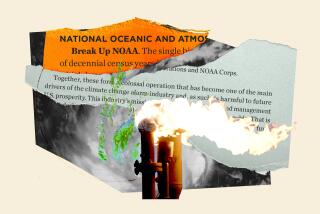Climate change is real: Just ask the Pentagon

President-elect Donald Trump has described global warming as a hoax, but Pentagon officials say Americans have a responsibility to prepare for the future.
Reporting from naval station norfolk, va. — A bitter wind blew across Sewell’s Point on a recent afternoon as ocean waves crashed against a concrete pier where two black attack submarines were tied up for the day.
Pier 3 was taking the last hits of a severe storm that had roared ashore a few days before. It flooded four buildings, tore up rooftops, knocked down trees and briefly cut electricity at the world’s largest naval station.
Storms obviously aren’t new here, but they are worse than ever — and the Pentagon blames climate change.
“We see the rising sea levels and flooding events,” said Capt. Dean VanderLey, who oversees Navy infrastructure in the mid-Atlantic region. “We have a responsibility to prepare for the future. We don’t have the luxury of just burying our heads in the sand.”
President-elect Donald Trump has described global warming as a hoax, and Republicans in Congress who reject science showing that greenhouse gases have warmed the planet have blocked funding meant to help the Pentagon assess the damage and plan for the future.
We have a responsibility to prepare for the future. We don’t have the luxury of just burying our heads in the sand.
— Capt. Dean VanderLey
The House voted in June to bar the Defense Department from spending money to evaluate how climate change would affect military training, combat, weapons purchases and other needs.
“When we distract our military with a radical climate change agenda, we detract from their main purpose of defending America from enemies” like Islamic State, said Rep. Ken Buck (R-Colo.), sponsor of the measure.
Partly as a result, the Pentagon says it does not keep figures on what climate change may mean for the military budget. Planners sometimes list upgrades to infrastructure as maintenance or repairs to avoid scrutiny from lawmakers.
But the debate is settled at the Pentagon. Rising sea levels and temperatures have forced it to rebuild or relocate roads, housing, air fields and other vulnerable facilities damaged by mudslides in Hawaii, floods in Virginia, drought in California and thawing permafrost in Alaska.
It also has led to a shift in strategic challenges around the globe.
The Pentagon doesn’t say that climate change alone will cause wars. But the 2014 Quadrennial Defense Review, the Defense Department’s major planning blueprint for the next four years, calls it an “accelerant of instability” and a “threat multiplier.”
“The pressures caused by climate change will influence resource competition while placing additional burdens on economies, societies, and governance institutions around the world,” the document said.
In Africa, extended droughts have been a factor in several sub-Saharan and North African conflicts. When rising temperatures created food and water shortages, for example, increased poverty and migration created breeding grounds for terrorist groups in Mali, Nigeria and elsewhere.
Similarly, increasingly powerful typhoons spawned from warming seas have battered U.S. allies in the western and central Pacific. Humanitarian aid operations, once a rarity, are expected to become a core Pentagon mission as natural disasters have steadily grown.
In the Asia Pacific region, rising sea levels could inundate island nations such as Fiji and Micronesia, push saltwater into groundwater supplies and croplands in Vietnam and Indonesia, and threaten major cities, including Manila, Shanghai and Jakarta, Indonesia.
Climate change is the “biggest long-term security threat” facing the region, Adm. Samuel J. Locklear III, then head of U.S. Pacific Command, said in 2013.
The Pentagon also expects to expand operations in the Arctic, the world’s fastest-warming region.
So much sea ice has melted that a northern shipping route over Russia and a northwest passage over Canada are now open to navigation and oil and gas exploitation for much of the year. Partly as a result, Russia is reopening Cold War-era military bases on its Arctic coastline.
The impact of global warming also is visible at some military bases in the United States.
At drought-stricken Ft. Irwin in California, north of Barstow, engineers have cut base water use by one-third by ripping out 20 acres of grass, installing low-flow urinals and toilets and building novel irrigation systems, among other changes.
A new $100-million water-treatment plant will tap underground aquifers for the 26,000 people on the base, which covers an area larger than Rhode Island.
“Without water, we have no mission,” said Muhammad Bari, director of public works. “We have to be ready to face the impacts from climate change.”
The Pentagon’s “Climate Adaptation Roadmap,” issued in 2014, pointed to the Hampton Roads area in Virginia, which includes Naval Station Norfolk and Langley Air Force Base, as a top concern.
The sea-level rise and land subsidence is causing increased tidal and storm flooding in the area. Saltwater intrusion already is a problem, with three rivers flowing into the Chesapeake Bay.
The low-lying region has recorded the fastest sea-level rise on the East Coast: 18 inches in the past century, according to the Navy.
By 2030, scientists project the sea to rise six more inches. The Navy expects the main road into the base to be underwater for two or three hours a day by 2040.
Incremental changes often are irreversible so it’s important to plan ahead, according to David Adams, director of climate policy on the White House’s National Security Council.
“It takes awhile for people to get it,” he said at an Oct. 19 panel on Norfolk at the World Resources Institute in Washington. “It doesn’t go boom.”
As a result, when the Navy constructed new barracks on base last year, officials directed they be built on a foundation four feet higher than construction codes required.
The base also replaced four single-level piers with new double-decker versions — at a cost of nearly $150 million each — to service and better provide heavy-weather mooring for aircraft carriers, guided missile destroyers and attack submarines.
Pier 3 probably will be upgraded next, VanderLey said.
“Anytime we think about the future, we have to factor in sea-level rise,” he said. “We definitely don’t have a solution on how to stop it. But we have to be as resilient as possible.”
Twitter: @wjhenn
ALSO
Holocaust scholar and Schindler author donates his archives to Chapman University
What would a recreational marijuana market in California look like?
Still fighting: Vietnam vets seek help for rare cancer
More to Read
Sign up for Essential California
The most important California stories and recommendations in your inbox every morning.
You may occasionally receive promotional content from the Los Angeles Times.











